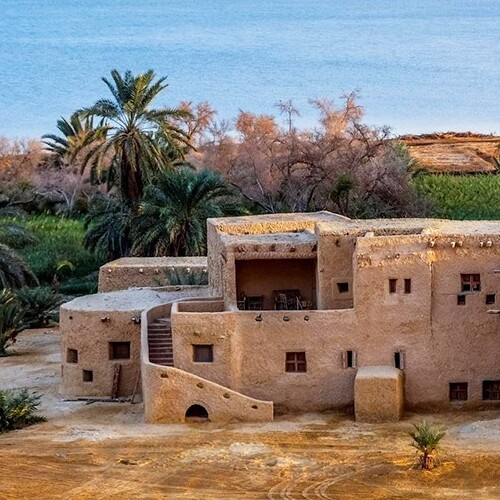No other nation in the world says ‘Welcome’ as often as the Egyptians, and every time, they mean it. While the ancient civilization of Egypt continues to amaze, contemporary Egyptians are equally remarkable.
Al Qasr Village
Al Qasr – The Old Town
Al Qasr, a town steeped in the rich tapestry of Egypt’s ancient history, stands as a testament to the once-flourishing capital of Bahariya Oasis. Today, known as el-Qasr, it harbors secrets of a bygone era, with archaeologists believing that beneath its surface lie many undiscovered monuments and artifacts.
Echoes of a Glorious Past
The remnants of a temple, now reduced to a solitary large stone, hint at Al Qasr’s historical significance. Nearby, at Qarat el-Hilwa, about 3 kilometers south, lies a cluster of tombs etched into a sandstone ridge – the oldest Pharaonic Period evidence in the area, suggesting an ancient cemetery integral to the town.
Tomb of Amenhotep: A Window into Antiquity
The most intriguing discovery is the tomb of Amenhotep, the Northern Oasis Governor from mid-Dynasty XVIII to early Dynasty XIX. Unique in its decorations, it provides an invaluable glimpse into the past. The forecourt is adorned with scenes of Amenhotep performing his duties, along with depictions of his son Menna and wife Ourly. Inside, two additional chambers feature funerary scenes reminiscent of Theban tombs from the same era.
However, time and weather have not been kind to this ancient marvel. Discovered by Ahmed Fakhry in 1938, much of the tomb’s wall scenes have succumbed to deterioration, with the roof now non-existent. While some reliefs have been reconstructed, the site is in dire need of more comprehensive restoration efforts.
The Stone Chapel for King Apries
In Al Qasr, two governors constructed a stone chapel dedicated to King Apries of Dynasty XXVI. Inscriptions on the stone feature the king’s name and those of the builders, Djedkhonsu-ef-ankh and Wahibrenefer, with text venerating the king as the “Lord of the Great Hill.” Notably, an alabaster statue of Djedkhonsu-ef-ankh, discovered here in 1900, now resides in the Cairo Museum.
The Enigmatic Deity Bes
Although no direct inscriptions to the dwarf deity Bes were found, a freestanding limestone statue of Bes, standing 1.37 meters tall, strongly suggests a dedication to this deity. This significant find is now a highlight in the centenary exhibition of the Cairo Museum.
Remnants of Ancient Splendor
Beyond Al Qasr, the Ain el-Muftillah spring, about 3 kilometers to the west, believed to have been the primary water source of the ancient capital, is now a desolate area marked by old house fragments and pottery shards.
Further excavations by Fakhry and others unearthed additional chapels with religious representations and scenes of various gods, dating back to Dynasty XXVI. These findings suggest that these chapels, initially thought to be independent, were actually part of a larger temple complex, one of the earliest to feature a pronaos.
Preserving the Past
In modern times, efforts to preserve these chapels have included burying them under sand and installing a wooden ceiling, safeguarding these rare remnants of ancient Egyptian religious architecture.
The Lost Triumphal Arch
The once-majestic Triumphal Arch, a Roman-era landmark, has suffered from centuries of neglect and repurposing of its stones for other constructions. Today, only a 10-meter-high platform and scattered ruins remain, their original grandeur lost to time.
In Al Qasr, the whispers of ancient Egypt resonate through the ruins, inviting visitors and historians alike to ponder over its once-glorious past and the mysteries that still lie buried within its sands.
Created On March 18, 2020
Updated On Aug , 2024
BAHARIYA OASIS Travel Guide



